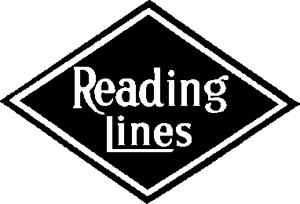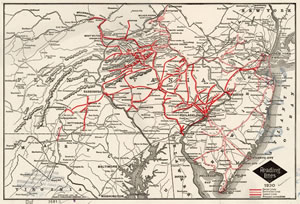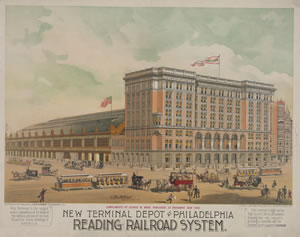
Perhaps best known for being an often-mispronounced stop on the classic Monopoly board, the Reading Railroad (pronounced Redding) is a testament to industrial Pennsylvania’s hey-day. Its life is a tragic ode to the decline of coal’s predominance during America’s extreme economic growth during most of the 20th century. The railroad is an icon that many people have forgotten yet some nostalgically cling to. Spanning 143 years, the Reading Railroad’s life mimicked the rolling hills and mountains it traversed.
The Reading, as it was affectionately called, played an integral part in the economic development of Philadelphia and the Schuylkill River Valley. Its origins began with the charter of the Philadelphia and Reading Railroad in 1833, and by 1849 it provided the connecting link between the resource rich coal regions of Schuylkill County and metropolitan Philadelphia. The anthracite coal industry would become the Reading’s catalyst, as the railroad continued to expand with each new rail line acquisition. Also adding to its rapid growth was the formation of the Philadelphia Coal and Iron Company that allowed the Reading to operate both the coal mines and the railroads stemming from them.
By the 1890s, the railroad had developed a large passenger network with three separate stations in the city of Philadelphia. The rail company chose to consolidate its Philadelphia terminals into one single endpoint. The station, as one familiar with Philadelphia may have guessed, was established above the Reading Terminal Market that still exists today and earned its name from the railroad terminal under which it was located.

The Reading continued to increase the size of its network through purchases in the Lehigh Valley and New Jersey, eventually securing a monopoly on the country’s anthracite trade. This web of lines proved difficult to manage, and the railroad, as well as its coal company, was reorganized under The Reading Company in 1896. With the 20th Century, came many difficulties for the company, which faced anti-trust lawsuits and was forced to drop its coal mine operations. After World War I, the Reading Company electrified most of its passenger rail lines in order to compete in the changing transportation climate.
During World War II, many of the company’s passenger lines reached record ridership. However, this trend would decline exponentially after the Second World War. Explains the Reading Eagle, “By the 1950s, forces beyond corporate control were pounding away at the fortunes of the Reading and other northeastern railroads. Heavy manufacturing was disappearing from the region; passengers were abandoning the rails for automobiles and airplanes; and convoluted federal regulations were hindering railroads from setting competitive shipping rates.” By the late 1960s, the company could not survive without subsidies from South Eastern Pennsylvania Transportation Authority, which would eventually take control of most passenger services by 1974. In 1976, the Reading Railroad, as history knew it, was no longer, and it was reorganized under a government conglomerate known as Conrail.
From its initial charter in 1833 to its bankruptcy in 1971, the railroad had gone from one of the largest corporations in the world to a flailing government-owned not-for-profit. The role that it played in the development of the Philadelphia area was tremendous. Whether the Reading was providing jobs for tens of thousands of rail workers across the region or shuffling businessmen between New York and Philadelphia, its economic impact was astounding.

Perhaps this impact is most favorably seen by the city from which the railroad received its name. The city of Reading, PA, witnessed a doubling of its population between 1880 and 1900 largely due to its central role as a transportation hub for the railroad. Today, the city clings nostalgically to its former role. The importance of the railroad to the city can be seen from the Berks County Historical Society’s exhibits on the Reading Railroad to the city’s arena football team, aptly named The Express. Every time the Reading Phillies minor league baseball team scores a run, a decorative train in the outfield lights up and the sound of a steam engine fills the stadium. States the City of Reading’s website, “The construction of the railroad was probably the single greatest factor in the development of Berks County.”
Many of the railways still exist today, but their frequency of use does not compare to that of the late 19th and early 20th centuries. Passenger rail between Reading and Philadelphia is no longer a reality. However, increasing oil prices and the growth of the Schuylkill Valley region have raised the possibility of restoring passenger rail service between Reading and Philadelphia. Time will only tell if the citizens of Reading get a modern version of their beloved train back.
From the time the Reading Railroad was featured on the original Monopoly board in 1934, the game has been played by almost 500 million people worldwide. Those who play the original version might be quick to categorize the Reading Railroad as a fictional railway, just a stop on the way to “pass go and collect $200.” However, to many in Southeastern Pennsylvania, the Reading Railroad is a known cultural and historical icon. It is a testament to America’s coming of age during the 20th century.
Sources:
- “Home.” Express Indoor Football. 7 Dec. 2009 <http://expressindoorfootball.com/>.
- Hinz, Christopher. “The Reading Railroad: An Icon for the Ages.” The Reading Eagle. 15 Apr. 2007. 1 Dec. 2009 <http://readingeagle.com/article.aspx?id=54098>.
- Megerdigian, Cheryl. “Philadelphia & Reading Railroad Company.” National Museum of American History. Aug. 1989. 30 Nov. 2009 <http://americanhistory.si.edu/archives/d8208.htm>.
- “Philly NRHS - Reading Company History.” TrainWeb. 6 July 2003. 1 Dec. 2009 <http://www.trainweb.org/phillynrhs/rdg.html>.
- Reading Railroad Online. 4 Dec. 2009 <http://www.readingrr.com/index.htm>.
- “Reading Railroad Massacre.” ExplorePAHistory. 1 Dec. 2009 <http://explorepahistory.com/hmarker.php?markerId=631>.
- “The History of Reading.” ReadingPA. 7 Dec. 2009 <http://www.readingpa.gov/history.asp>.
- “The Reading Railroad.” The American Railroads. 30 Nov. 2009. 10 Dec. 2009 <http://www.american-rails.com/reading-railroad.html>.
